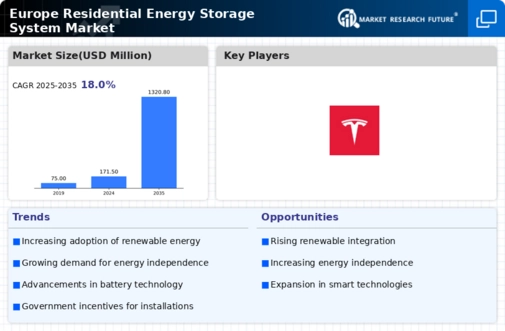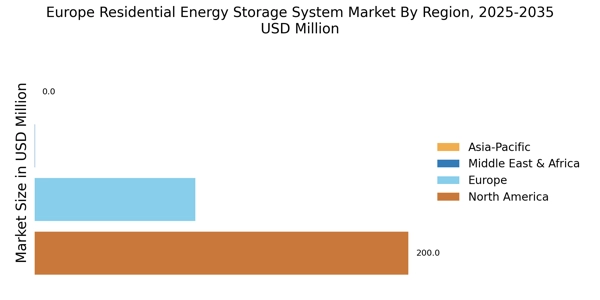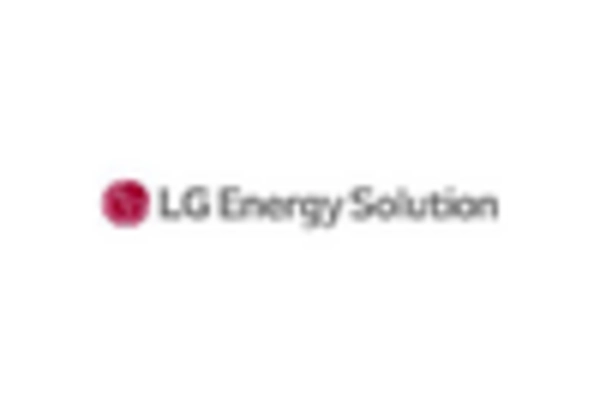Rising Electricity Prices
The continuous rise in electricity prices across Europe is likely to drive the demand for residential energy storage systems. As households face increasing energy costs, the appeal of energy storage solutions becomes more pronounced. By investing in energy storage, consumers can store energy during off-peak hours when prices are lower and utilize it during peak hours, thereby reducing their overall energy expenses. Data suggests that residential electricity prices in Europe have seen a steady increase, which may further incentivize homeowners to consider energy storage systems as a viable solution. This trend indicates a growing recognition of the potential savings and energy independence that these systems can offer, thereby propelling the Europe Residential Energy Storage System Market Industry forward.
Regulatory Framework and Policy Support
The regulatory framework and policy support for renewable energy and energy storage systems are essential drivers in the Europe Residential Energy Storage System Market Industry. Governments across Europe are implementing policies that promote the adoption of energy storage technologies, including subsidies, tax incentives, and favorable regulations. These initiatives aim to facilitate the transition to a more sustainable energy system and encourage consumers to invest in energy storage solutions. The European Commission's Green Deal, which outlines ambitious targets for renewable energy integration, further underscores the importance of supportive policies. As these regulatory measures continue to evolve, they are likely to create a more conducive environment for the growth of residential energy storage systems.
Integration with Smart Home Technologies
The integration of residential energy storage systems with smart home technologies appears to be a pivotal driver in the Europe Residential Energy Storage System Market Industry. As consumers increasingly adopt smart home devices, the synergy between these technologies and energy storage systems enhances energy management and efficiency. This integration allows homeowners to monitor and control their energy usage in real-time, optimizing the use of stored energy. Reports indicate that the smart home market in Europe is projected to grow significantly, which could further bolster the adoption of energy storage solutions. Consequently, this trend may lead to a more sustainable energy ecosystem, where energy storage systems play a crucial role in managing energy consumption and reducing reliance on the grid.
Technological Advancements in Energy Storage
Technological advancements in energy storage technologies are playing a crucial role in shaping the Europe Residential Energy Storage System Market Industry. Innovations in battery technology, such as lithium-ion and solid-state batteries, have improved the efficiency, lifespan, and cost-effectiveness of energy storage systems. These advancements make energy storage solutions more accessible to a broader range of consumers. Furthermore, ongoing research and development efforts are likely to yield even more efficient and affordable options in the near future. As technology continues to evolve, it may enhance the appeal of residential energy storage systems, encouraging more homeowners to invest in these solutions and thereby driving market growth.
Environmental Concerns and Sustainability Goals
Heightened environmental concerns and the pursuit of sustainability goals are influencing consumer behavior in the Europe Residential Energy Storage System Market Industry. As awareness of climate change and its impacts grows, many consumers are seeking ways to reduce their carbon footprint. Energy storage systems facilitate the use of renewable energy sources, such as solar and wind, by storing excess energy for later use. This capability aligns with the European Union's ambitious climate targets, which aim for significant reductions in greenhouse gas emissions. The increasing emphasis on sustainability may lead to a surge in demand for energy storage solutions, as consumers strive to adopt greener technologies and contribute to a more sustainable future.


















Leave a Comment